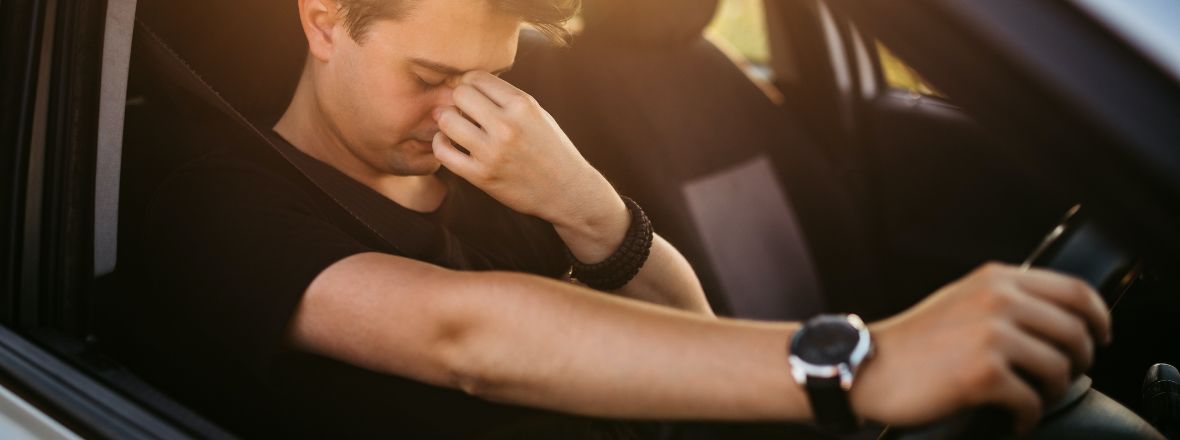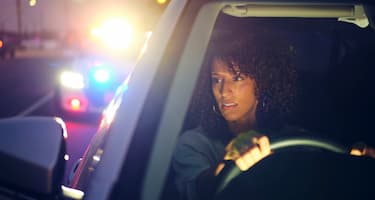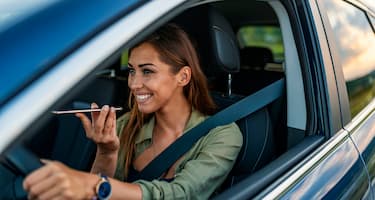How much do Australians know about fatigued driving? We’ve gathered all the important statistics on road safety, as well as our own survey data, to determine just how dangerous fatigued driving is.
Quick Stats
Nearly a third (30.1%) of Australian respondents have experienced a microsleep, or a fatigued moment they couldn’t remember while driving.
12.4% of respondents had driven for more than 6 hours without taking a break.
76% of respondents who had experienced a microsleep also thought that driving while highly fatigued was the most dangerous state to drive in.
We all know that driving while sleepy can be dangerous. But as something that affects us all, how aware are Australians of the risks it can carry? And compared to other dangerous driving behaviours, how much of a threat is fatigued driving?
In May 2022, we surveyed 886 Australian participants 18+ through Pure Profile to gauge whether Australians understand the risks of fatigued driving, and how they stay alert behind the wheel.
1.0 What counts as ‘fatigued driving’?
‘Fatigue’ simply refers to your tiredness. This doesn’t necessarily mean you’re falling asleep at the wheel – ‘fatigued driving’ begins when you’re simply not able to concentrate to your normal ability.
There are plenty of causes for driver fatigue, including:
- Lack of quality sleep – Even if your sleep schedule is okay, certain medical conditions can prevent you from getting value out of your sleep.
- A lot of time spent driving – Concentrating on the road for extended periods can significantly sap your mental stamina, causing fatigue.
- Lack of stimulation – Believe it or not, highway driving (or driving on long stretches of straight road) can increase your rate of fatigue.
- Your work/social schedule – A drive that might seem easy most days could be dangerous if you’re overworked, or drained from social events.
What is 'microsleeping'?
According to the NSW Government, ‘microsleeping’ is when your body experiences short periods of unconsciousness. While this might seem unusual, it’s actually one of the first stages of falling asleep and is incredibly common [1]. Most of the time, people won’t know or remember that they briefly fell asleep.
Professor Leon Lack at the Flinders University of South Australia says you can spot microsleeping almost every day:
“Someone could be clinically asleep, in a light sleep, and you could ask them ‘Are you asleep?’ and they’ll answer you ‘No, I’m awake’ but if you ask them to tell you what was just on the radio or TV in the background, they won’t be able to tell you.”
2.0 The risks of driving while fatigued
It’s quite well-known that driving while fatigued can be dangerous. In fact, being awake for around 17 hours has the same sort of effect on your driving as a blood alcohol level of 0.05[1]. But this doesn’t necessarily show how it affects your ability to drive.
Your reaction time decreases
When tested in experimental conditions, young male drivers’ reaction times were nearly doubled when they were very tired [3].
Your performance is impaired
The accuracy and quality of your driving decreases significantly when driving under fatigued conditions.
Your speed can vary
As you lose focus, the speed of your car can vary wildly, from significantly under the speed limit to dangerously over.
Your lane control will suffer
With less awareness of your speed and decreased reaction times, it’s easy for your vehicle to slip out of its lane.
Information courtesy of the Queensland Government[2].
3.0 Fatigued Driving Survey Results
3.1 How long does a typical “microsleep” last for?
Nearly 60% of respondents correctly answered that a typical “microsleep” lasts less than 30 seconds.
67% of respondents aged 55-64 answered that a typical “microsleep” lasts less than 30 seconds - a higher rate than any other age group. 18-24 year old respondents had the lowest rate of correct answers, with only 41% finding the correct answer.
3.2 Have you ever experienced a microsleep or a fatigued moment you couldn’t remember while driving?
Yes |
No |
|
|---|---|---|
18-24 |
28.2% |
71.8% |
25-34 |
38.0% |
62.0% |
35-44 |
30.6% |
69.4% |
45-54 |
31.5% |
68.5% |
55-64 |
29.0% |
71.0% |
65+ |
23.1% |
76.9% |
Nearly a third of Australian respondents have experienced a microsleep, or a fatigued moment they couldn’t remember while driving.
38% of respondents who have experienced a microsleep while driving were in the 25-34 age bracket.
Respondents from Tasmania had both the lowest percentage (17.6%) of respondents who have experienced a microsleep and the highest percentage (82.4%) of respondents who haven’t experienced a microsleep, or a fatigued moment they couldn’t remember while driving.
3.3 What is the most amount of time that you have driven without taking a break?
12.4% of respondents had driven for more than 6 hours without taking a break.
19% of male respondents have driven more than 6 hours without taking a break (compared to just 6% of female respondents).
41% of respondents aged 18-24 had only driven for 2 hours or less without taking a break. As the number of hours driven increased, the number of 18-24-year-olds driving for longer periods decreased.
Respondents from Western Australia were the most likely (15%) to drive for more than 6 hours without a break. This correlates to Western Australia being the largest state in Australia.
Out of the respondents who had driven for more than 6 hours without a break, 21% of them had also experienced a microsleep while driving. These data also show that respondents were more likely to experience a microsleep, the longer they drove without a break.
Average Longest Drive (Hours) |
|
|---|---|
Australia |
3.64 |
Average Longest Drive (Hours) |
|
|---|---|
Female |
2.88 |
Male |
4.43 |
Average Longest Drive (Hours) |
|
|---|---|
18-24 |
2.28 |
25-34 |
3.61 |
35-44 |
3.66 |
45-54 |
3.80 |
55-64 |
3.79 |
65+ |
3.68 |
Average Longest Drive (Hours) |
|
|---|---|
NSW |
3.76 |
Vic |
3.36 |
Qld |
3.96 |
WA |
3.19 |
SA |
3.49 |
Tas |
3.94 |
Average Longest Drive (Hours) |
|
|---|---|
Never Microslept Driving |
3.22 |
Had Microsleep Driving |
4.61 |
Male respondents' longest drive averaged 4.43 hours and were much more likely to drive for longer than female respondents.
Respondents aged 18-24 averaged the shortest drive out of all the age groups. This may be attributed to this group’s lack of driving experience compared to other age groups.
Respondents from Queensland had the longest average driving time.
Respondents who had experienced a microsleep while driving averaged longer drives, on average, than those who hadn’t. In actuality, this more likely suggests that drivers who travel for long stretches of time at night are more likely to experience a microsleep..
3.5 If you drive at night or when feeling fatigued, what techniques will you regularly use to stay alert?
Play music or the radio |
Share the drive with someone who is more rested |
Drink water, and/or have a snack |
Pull over at a Driver Reviver, or service centre for a break |
Consume something with caffeine, like coffee or an energy drink |
None of the above |
|---|---|---|---|---|---|
67.6% |
59.7% |
57.0% |
56.5% |
56.4% |
3.6% |
Play music or the radio |
Share the drive with someone who is more rested |
Drink water, and/or have a snack |
Pull over at a Driver Reviver, or service centre for a break |
Consume something with caffeine, like coffee or an energy drink |
None of the above |
|
|---|---|---|---|---|---|---|
Female |
69.6% |
64.4% |
58.4% |
52.5% |
56.4% |
3.0% |
Male |
65.6% |
54.8% |
55.5% |
60.8% |
56.5% |
4.3% |
Play music or the radio |
Share the drive with someone who is more rested |
Drink water, and/or have a snack |
Pulled over at a Driver Reviver, or service centre for a break |
Consume something with caffeine, like coffee or an energy drink |
None of the above |
|
|---|---|---|---|---|---|---|
18-24 |
56.4% |
64.1% |
46.2% |
30.8% |
56.4% |
0.0% |
25-34 |
77.3% |
58.3% |
69.3% |
49.7% |
69.9% |
2.5% |
35-44 |
76.7% |
53.3% |
57.8% |
52.2% |
63.9% |
2.2% |
45-54 |
71.3% |
58.0% |
65.0% |
61.5% |
59.4% |
0.7% |
55-64 |
59.3% |
66.9% |
52.4% |
62.8% |
48.3% |
6.9% |
65+ |
56.5% |
61.8% |
45.2% |
63.4% |
41.4% |
6.5% |
Play music or the radio |
Share the drive with someone who is more rested |
Drink water, and/or have a snack |
Pull over at a Driver Reviver, or service centre for a break |
Consume something with caffeine, like coffee or an energy drink |
None of the above |
|
|---|---|---|---|---|---|---|
NSW |
60.8% |
65.0% |
53.6% |
62.4% |
59.3% |
60.8% |
Vic |
67.0% |
54.3% |
60.2% |
51.1% |
59.7% |
67.0% |
Qld |
74.0% |
61.9% |
59.7% |
60.2% |
51.4% |
74.0% |
WA |
73.6% |
48.4% |
54.9% |
48.4% |
54.9% |
73.6% |
SA |
70.8% |
67.7% |
58.5% |
55.4% |
55.4% |
70.8% |
Tas |
64.7% |
47.1% |
41.2% |
52.9% |
52.9% |
64.7% |
Play music or the radio |
Share the drive with someone who is more rested |
Drink water, and/or have a snack |
Pull over at a Driver Reviver, or service centre for a break |
Consume something with caffeine, like coffee or an energy drink |
None of the above |
|
|---|---|---|---|---|---|---|
Never Microslept Driving |
64.0% |
61.0% |
52.3% |
54.7% |
53.2% |
5.0% |
Had Microsleep Driving |
76.0% |
56.6% |
67.8% |
60.9% |
64.0% |
0.4% |
Only 59.7% of Australian respondents shared the drive with someone who is more rested so that they could stay alert. This is one of the recommended ways that can help you manage driver fatigue.
Female respondents were more likely to play music or the radio and drink water and/or have a snack whereas male respondents were more likely to pull over at a Driver Reviver, or service centre for a break.
Interestingly the older a driver was, the more likely they were to pull over at a Driver Reviver, or service centre for a break.
74% of respondents from Queensland liked to play music or the radio to stay alert. This was closely followed by respondents from Western Australia and South Australia.
0.4% of drivers who have experienced a microsleep before answered “none of the above”. This means that 99.6% have tried another technique on this list before.
3.6 Which of these would you feel is the most dangerous state for a driver to be in?
Driving while highly fatigued |
Driving while texting |
Driving slightly over the legal blood alcohol limit |
Driving without a seatbelt on |
|---|---|---|---|
52.1% |
29.8% |
13.4% |
4.7% |
Driving while highly fatigued |
Driving while texting |
Driving slightly over the legal blood alcohol limit |
Driving without a seatbelt on |
|
|---|---|---|---|---|
NSW |
55.1% |
22.4% |
17.5% |
4.9% |
Vic |
52.9% |
32.1% |
11.3% |
3.6% |
Qld |
48.1% |
33.7% |
12.2% |
6.1% |
WA |
57.1% |
30.8% |
9.9% |
2.2% |
SA |
46.2% |
38.5% |
12.3% |
3.1% |
Tas |
47.1% |
29.4% |
11.8% |
11.8% |
Over half of all Australian respondents thought that driving while highly fatigued is the most dangerous state for a driver to be in.
Nearly 60% of respondents from WA thought that driving while fatigued was the most dangerous.
3.7 In minutes, what is the furthest you would feel comfortable driving if you were feeling tired?
Average Drive (Minutes) |
|
|---|---|
Australia |
29.3 |
Average Longest Drive (Minutes) |
|
|---|---|
Female |
25.9 |
Male |
32.8 |
Average Longest Drive (Minutes) |
|
|---|---|
18-24 |
33.6 |
25-34 |
34.6 |
35-44 |
33.8 |
45-54 |
27.8 |
55-64 |
25.2 |
65+ |
23.7 |
Average Longest Drive (Minutes) |
|
|---|---|
NSW |
30.7 |
Vic |
28.3 |
Qld |
29.2 |
WA |
27.4 |
SA |
27.5 |
Tas |
25.1 |
Average Longest Drive (Minutes) |
|
|---|---|
Never Microslept Driving |
26.5 |
Had Microsleep Driving |
35.8 |
Male respondents are more comfortable driving further if they were feeling tired than their female counterparts.
As the respondents aged, the amount of time they would drive while feeling tired decreased.
Surprisingly respondents from New South Wales felt comfortable driving the longest amount of time if they were feeling tired.
Unsurprisingly respondents who had experienced a microsleep while driving were more comfortable driving for longer than those respondents who had not experienced a microsleep while driving
4.0 Key Findings
Drivers who travel further have higher rates of microsleeps
Alarmingly, respondents who had experienced a microsleep while driving were more likely to have driven further and were more comfortable driving for longer than those respondents who had not experienced a microsleep while driving.
Australians agree, driving while fatigued is the most dangerous way to drive
Out of the four options available, driving while highly fatigued, driving while texting, driving slightly over the legal blood alcohol limit and driving without a seatbelt on, half of the Australian respondents correctly identified that driving while highly fatigued was the most dangerous state to drive in.
There’s only one way to prevent a microsleep - getting proper rest
Respondents who admitted to experiencing a microsleep may have tried any combination of the usual prevention techniques. However, the only way to prevent a microsleep is not driving and getting some proper rest.
More importantly, you shouldn’t try to continue driving if you notice you’re fatigued. The risks are too high, and there aren’t any sufficient alternatives that can quickly fix your ability to concentrate on the road.




